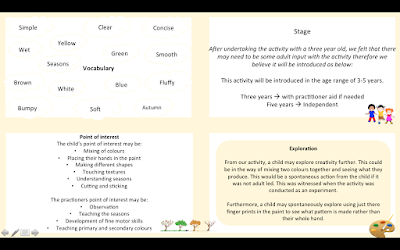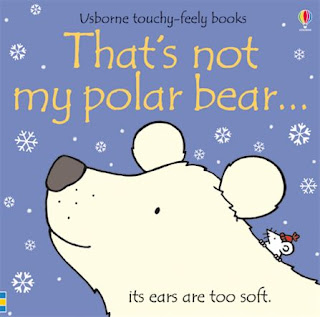Members: Ashley
Mason, Charlotte Ainsworth and Megan Nelli
Reasons for Selection:
•As a
group we have decided to combine two of the provisions that were of interest to
us all
•These
are creative
play and literacy
•We
have chosen creative play due to the lack of opportunities we found for the
children whilst we have been in placements. We felt that due to the potential
mess and cleaning up time, some practitioners may be in favour of an activity
involving minimal preparation and resources, making it easier to clear away to
proceed the next activity.
•From
choosing creative provision, we then researched activities within this topic
leading us to our final decision of using paint within
our project.
•Literacy
was a common interest within the group, therefore we have decided to use both
provisions within our project.
•From
our own challenges as children, we preferred to be hands on with creative play
using paint or cutting and sticking rather than choosing academic work such as
literacy and mathematics. For this reason, we chose to have both provisions in
our activity to encourage children to enjoy all areas of provision.
Activity:
1.Circle time at the beginning to ensure
everyone is included and that all children understand the aims and outcomes of
the activity. Throughout circle time prior to the activity, it can be discussed
about the season we are currently in and give the children an opportunity to
share their thoughts on what happens in autumn and what they associate with
autumn. Through this, some answers may link to the tree. However if they don’t,
autumnal colours can be introduced. Once these points have been discussed, a brief
overview of the activity will be given.
2.With the creative area already set with
the resources, the children will then be allowed to go and complete their hand prints for the tree.
Simple image instructions will be available on the table for children to look
at should they need any additional help. This therefore means that the activity
could be completed without adult input.
3.Once the hand prints have been completed,
the children will allow them to dry. Throughout any time whilst the hand prints
are drying, the children will have the chance to practice writing their names
with the use of a dot to dot template.
4.When they have dried, the children will
write their names on their hand print leaf. This could be with the use of the
dot to dot template or however for those that can attempt it without due to the
previous practice can do so without.
5.The children will then cut out their hand
print leaves and stick them on to the branches of “Our Friendship Tree”.
Reflection:
Planning and creation
As
a whole, we believe that the planning and creation of our activity has been
successful. Tasks were delegated to those in our group and completed within the
time frames and targets that we set to allow us to move on to the next step of
the product. We
struggled with the creativity of the tree, however we overcome this barrier by
researching other examples of excellence.
Improvements and changes on planning and
creation
If
we were to carry out this task again we would carry out our activity in various
settings rather than just one with different age groups in order to find our
target audience for our activity. This would allow us to tailor our activity to
the needs of different children.
Carrying out the activity
We
were able to set out the activity before hand. It could have been more
beneficial if we had a table to work at however we improvised well by using the
floor covering it with paper. When carrying out the activity we didn’t have too
much of a time slot. The leaves were wet therefore the students were unable to
write directly onto the leaves. However these were stuck on, on separate pieces
of white paper whilst the paint was still wet. We think that the participants
enjoyed our activity.
Improvements and changes on carrying out
the activity
If
we were to carry out the activity again, it would improve it if we had more
time to do so. This would allow leaves to dry so the child can therefore write
on their leaf that they have created. Additionally, this would enable more time
for the handwriting of the names to be practiced as well as completing the
extension activity. Furthermore, we would ensure there was table space for the
larger tree to sit on with the children around it to therefore show what the
leaves will be being used for.








































